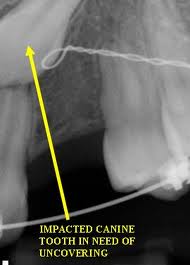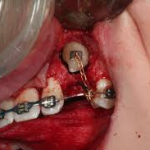When a tooth fails to emerge through the gums, it is considered to be an impacted tooth. This commonly occurs in the case of canine teeth.
It is important to treat an impacted tooth in order to prevent the improper eruption of nearby teeth, cyst formation, possible infection or other negative changes in the jaw.
In order to determine the correct treatment for you, your dentist will examine your teeth and radiographs to determine the position of the impacted tooth as well as the condition of your gums. One of the treatment options is to surgically expose the tooth in order to guide it to the right position in your jaw. In most cases, you will need to have space created in your jaw through orthodontics prior to the surgical treatment.
Depending on the location, there are different methods of accomplishing the surgical exposure of your tooth.
If the impacted canine is close to the palate, your dentist will have two options depending on the exact position of the tooth.
The first option is for your dentist to expose the tooth in order to allow it to erupt on its own. Once the surgery is completed, your dentist may place a protective dressing over the surgical site while it heals. This method will allow the canine tooth to emerge until it is at the level of the adjacent teeth, after which the teeth can be aligned with braces.
The second option is for your dentist to expose the tooth and then attach an orthodontic bracket to it either at the time of surgery or shortly after in order to help guide the tooth to the level of the adjacent teeth.
If the impacted canine is close to the outer, facial, aspect of the upper jaw, your dentist will have three different treatment options, depending on the exact position of the tooth and the condition of your gums.
 In the first option, your dentist will expose the tooth and reposition your gums so as to leave some of the crown of the tooth exposed. He or she will then attach an orthodontic bracket to the tooth and use it to guide the tooth to its proper position. Open eruption technique may be an effective technique in cases with eruption delay due to early loss of deciduous tooth/teeth
In the first option, your dentist will expose the tooth and reposition your gums so as to leave some of the crown of the tooth exposed. He or she will then attach an orthodontic bracket to the tooth and use it to guide the tooth to its proper position. Open eruption technique may be an effective technique in cases with eruption delay due to early loss of deciduous tooth/teeth
The steps or phases for orthodontically assisted eruption are:
1. Gaining Access into Impacted Tooth/Teeth.
2. Button/Bracket placement.
3. Impacted tooth/teeth traction by elastic chains/ligature wire.
4. Button “if existed†is replaced by a bracket; the installed bracket on the impacted tooth/teeth is/are attached directly into the arch wire.
5. Tooth/teeth is/are completely erupted and “Braces†Removed.
The second option is called a closed technique because, after the dentist exposes the tooth, he or she will attach a bracket to it and then replace your gums back to their original position. Only the orthodontic wire will be visible through your gums while the tooth is guided to its proper
position. Once your orthodontic treatment is completed, minor recontouring of your gums may be necessary. The closed eruption technique is believed by some to be the best method of uncovering labially impacted teeth, especially if the tooth is located high above the mucogingival junction or deep in the alveolus where an apically positioned flap may be difficult or impossible to use successfully.
In the third method, your dentist will create a window through the gums to the surface of the tooth. He or she will then attach an orthodontic bracket to the tooth to help guide it to its proper position. Following orthodontic treatment, your dentist may place a gum graft at the neck of the tooth in order to replace any missing gum tissue.
If stitches were used during your surgical procedure, you may need to have them removed 1 to 2 weeks post-operatively. Regardless of which treatment you have received, you must avoid chewing on the surgical site for 2 weeks following your surgery. If prescribed, you must rinse with Chlorhexidine twice daily for 2 minutes until the surgical site is comfortable and you can resume good dental hygiene, which is, brushing and flossing daily. At the time of surgery, the dentist will provide you with the appropriate pain medication, or will prescribe pain medication for the post operative period.
 Surgically exposing and aligning impacted canines can prevent further damage to your dentition. In conjunction with subsequent orthodontic treatment, it can result in a more aesthetically pleasing appearance.
Surgically exposing and aligning impacted canines can prevent further damage to your dentition. In conjunction with subsequent orthodontic treatment, it can result in a more aesthetically pleasing appearance.
The main side effects and complications of orthodontically assisted eruption are:
1. Ankylosis.
2. Resorption.
3. Traumatization of nearby structures.
4. “Collision†with the adjacent roots.
